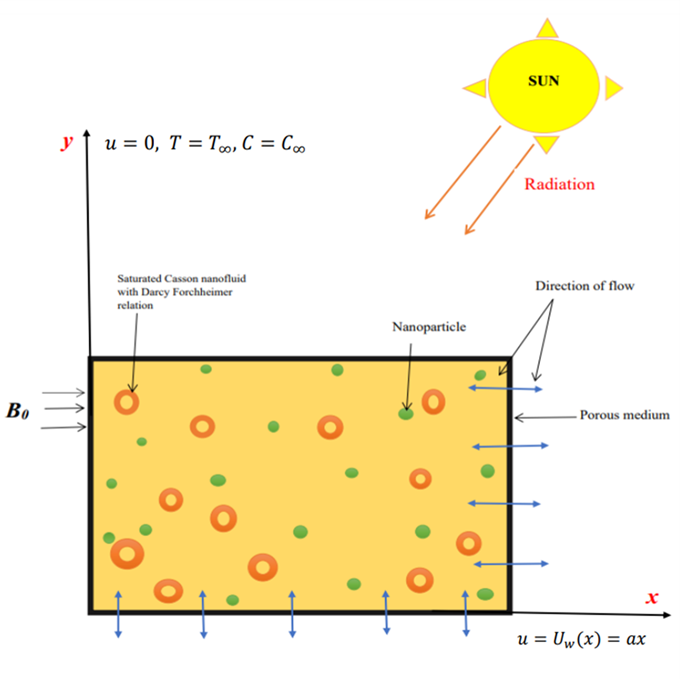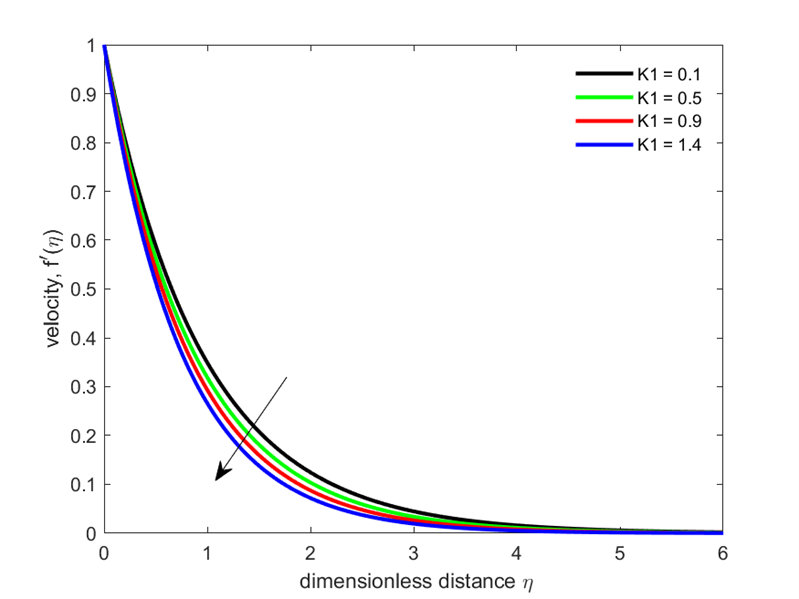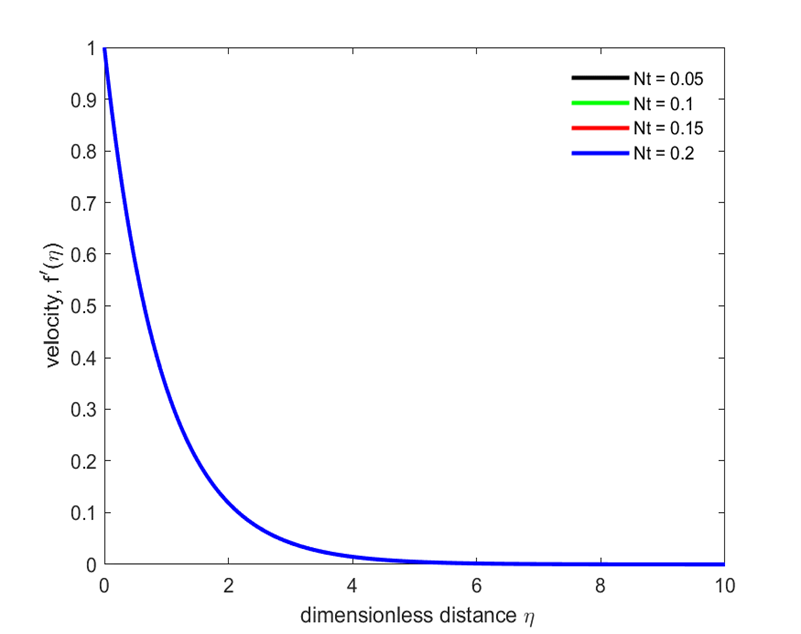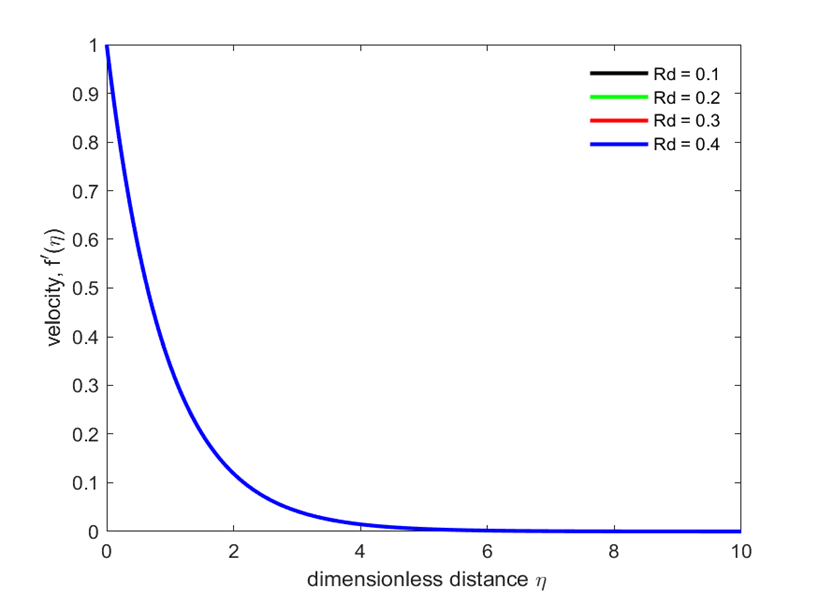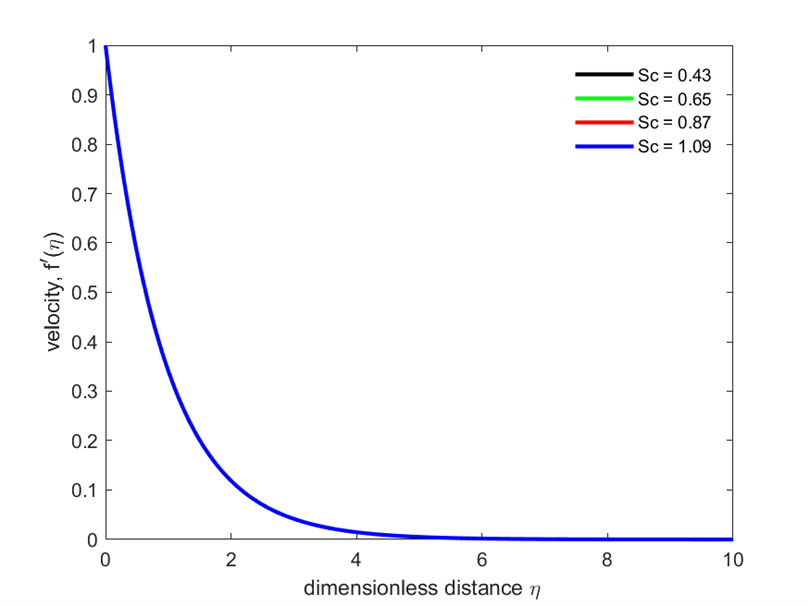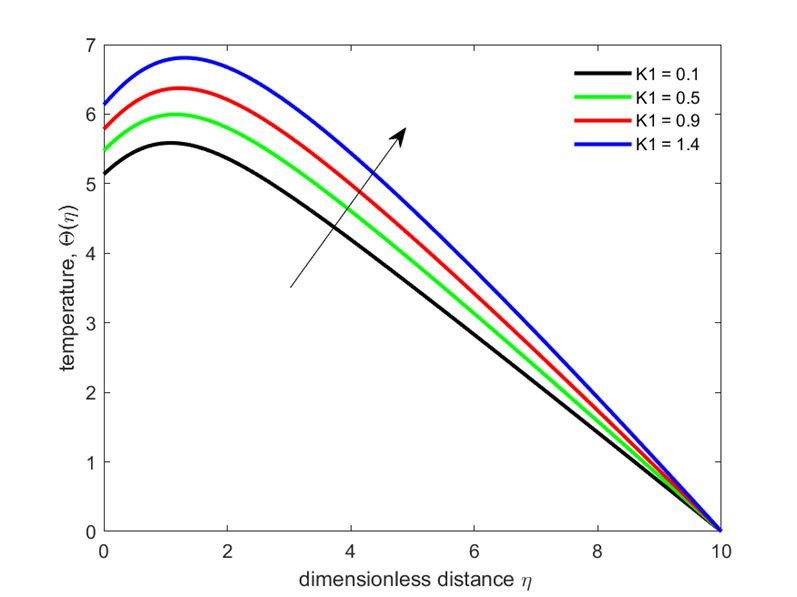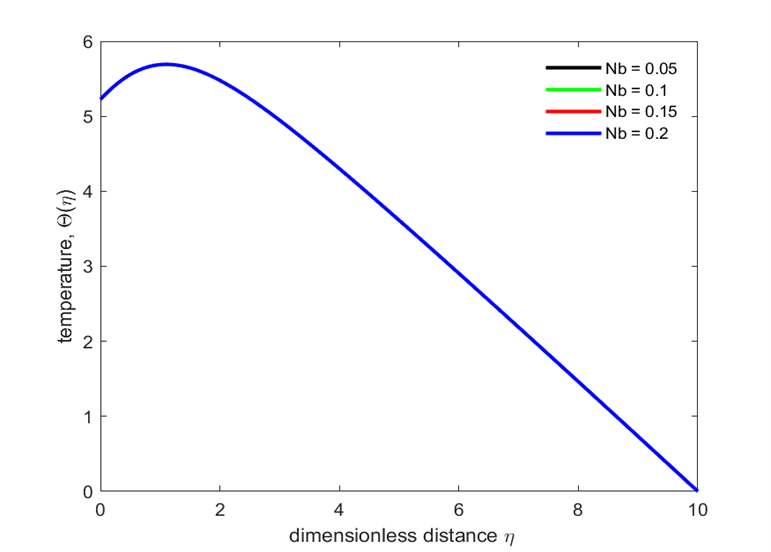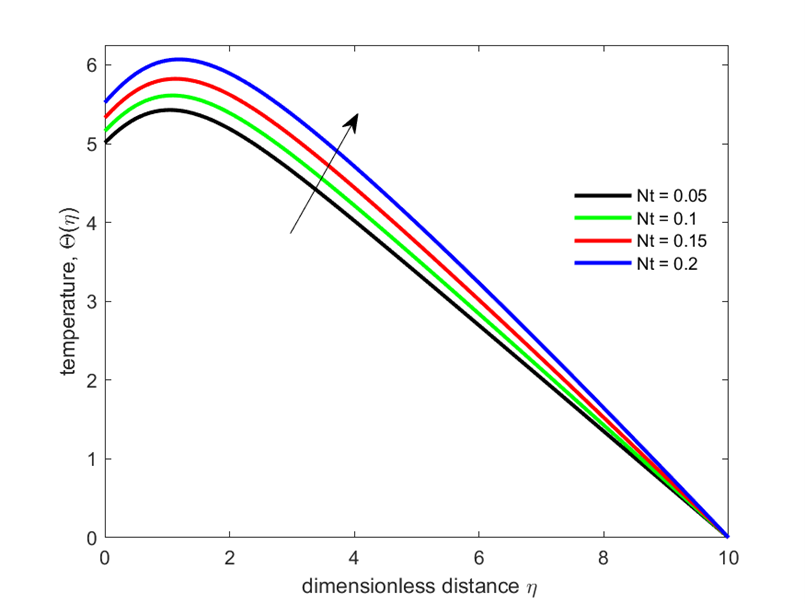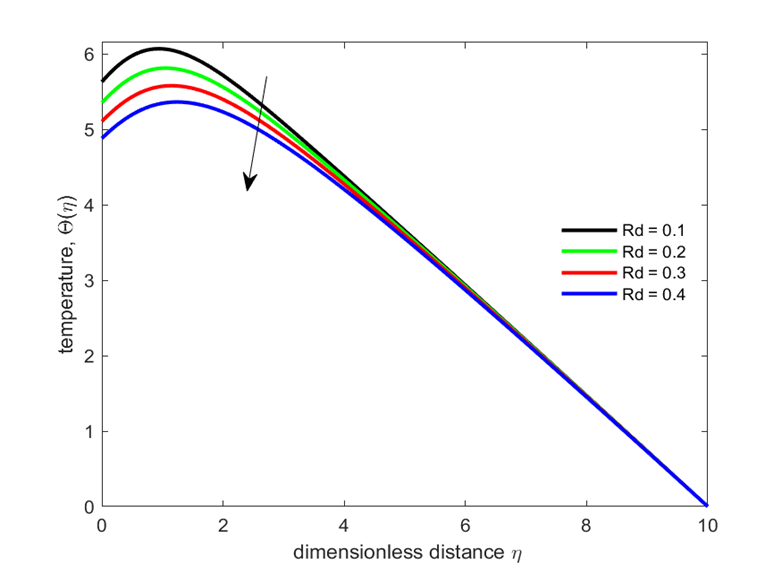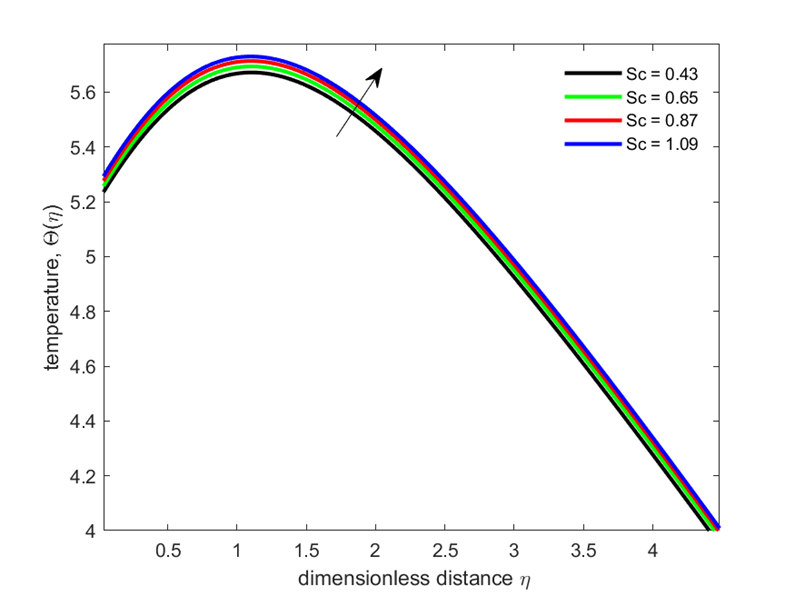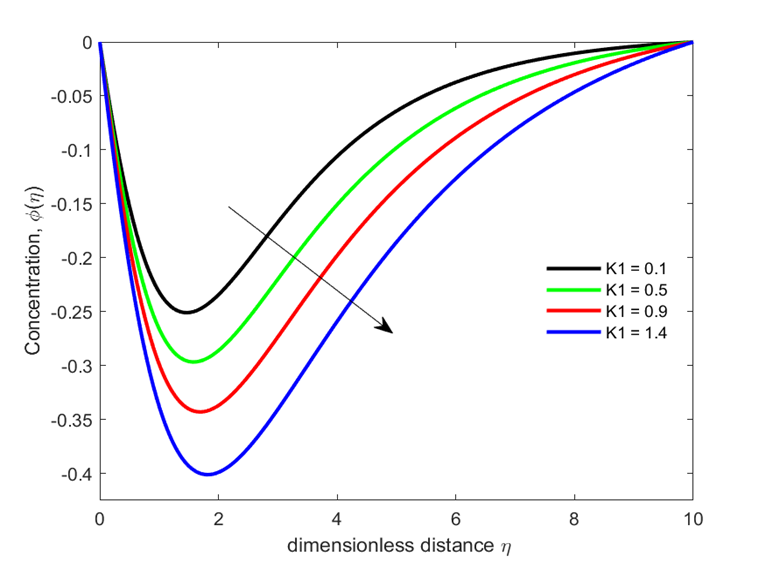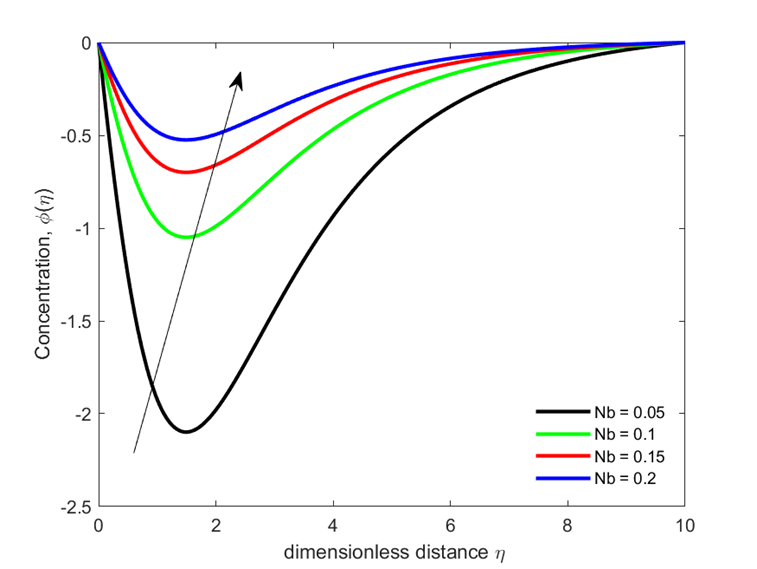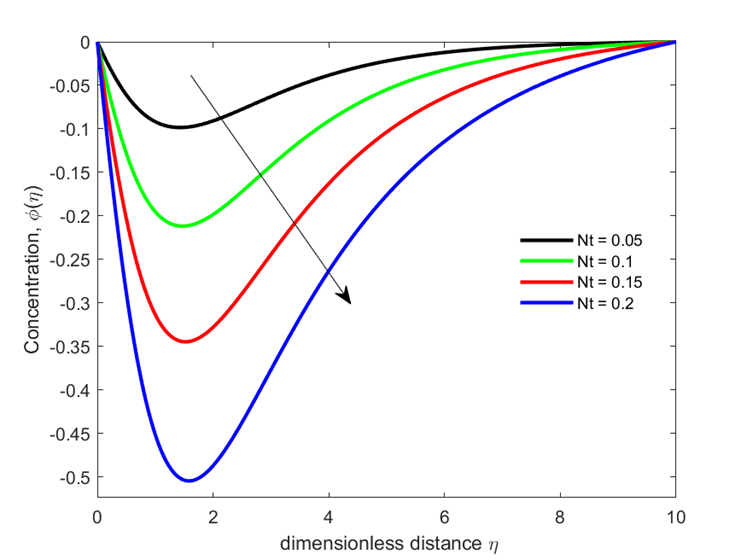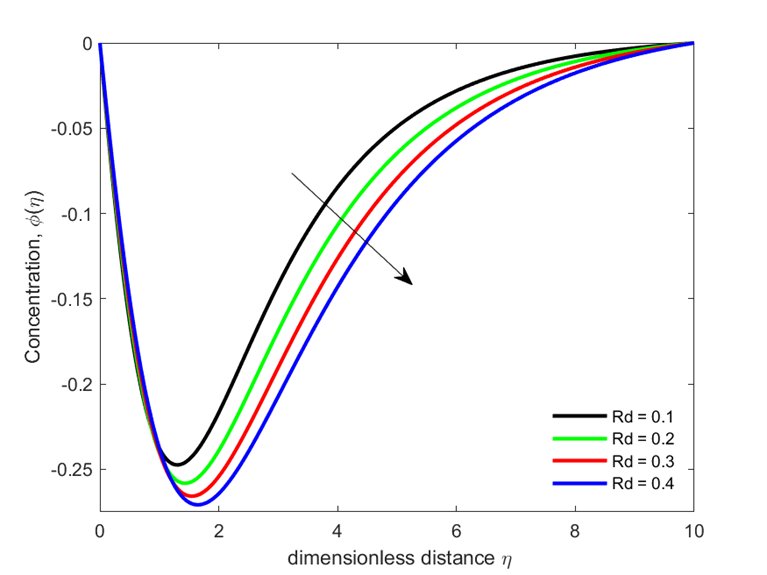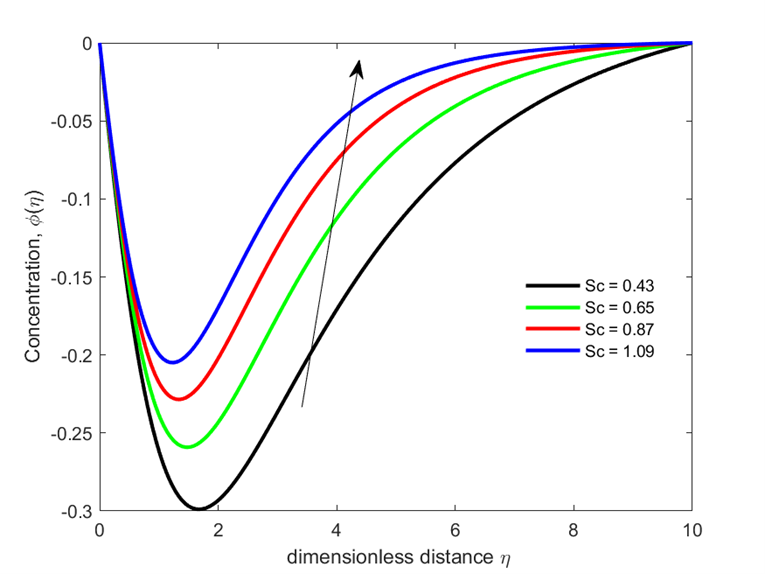Thermal Radiation on Darcy Forchheimmer Flow of a Casson Nanofluid
- Valerie Sasha Loco
- Winifred Nduku Mutuku
- 232-246
- Jun 7, 2024
- Physics
Thermal Radiation on Darcy Forchheimmer Flow of a Casson Nanofluid
Valerie Sasha Loco, Winifred Nduku Mutuku
Department of Mathematics and Actuarial Science, Kenyatta University, Nairobi, Kenya
DOI: https://doi.org/10.51584/IJRIAS.2024.905021
Received: 29 April 24; Accepted: 08 May 2024; Published: 07 June 2024
ABSTRACT
Owing to Casson nanofluids’ enhanced thermophysical properties, it has a wide range of applications in the fields of mining, drilling operations, material science, metallurgy, food manufacturing, and nanotechnology and bio-engineering. Casson fluid is frequently modelled since the model has a great agreement with the rheological evidence about human blood. Some of its applications in technological, industrial, mechanical, and scientific disciplines include; grain storage, geothermal energy production, designing warm protectors, artificial dialysis, catalytic converters, circulation of water in reservoirs and fermentation processes. On the other hand, radiation heat transfer mechanism has an immense impact in industries, engineering, technological fields where apparatus operate at extremely high temperatures. In this paper, the effects of thermal radiation on Darcy Forchheimer flow of a two- dimensional, steady, incompressible flow of Casson Nanofluid over a linear stretching surface are studied. The equations governing the fluid flow are formulated, then transformed to a system of ordinary differential equations using similarity variables then, the resulting ordinary differential equations are solved using the fourth order Runge- Kutta Method. The model is simulated using MATLAB bvp4c to demonstrate the impact of pertinent parameters on the temperature, velocity, and concentration of the fluid. It was observed that an increase in the thermophoretic parameter leads to an increase of the temperature at the boundary. The concentration of the fluid decreases with an increase porosity parameter value. Increasing the Brownian Motion parameter leads to an increase in concentration. An increase in Schmidt number leads to a decrease in temperature. Schmidt number increases with a decrease in concentration. The velocity and temperature profiles decrease with an increase in porosity parameter and an increase in thermal radiation leads to an increase of heat energy on the surrounding of a system leading to a decrease in fluid’s flow temperature.
Keywords: Thermal Radiation, Casson Nanofluid, Darcy Forchheimer flow, Thermophoresis diffusion, Brownian Motion, Porous media permeability.
INTRODUCTION
Nanofluids popularity in the recent decade has increased. Recent advancements in nanoscience have resulted in enhancement of thermophysical properties of nanofluids. This is beneficial in the industrial sector, its various applications of nanofluids include the reduction of friction, solar absorption, nuclear cooling, and delivering nano drugs among others. It has also led to the adoption of environmentally friendly renewable energy sources such as solar energy whereby a Parabolic Trough Solar collector puts to use the energy from the sun by reflecting and focusing sunlight using a concave mirror onto a tube containing a fluid which in turn absorbs the heat and changes it into usable energy. Das et al.,[3], Wang and Mujumdar (2008) and Murshed et al., [11] all concluded that the rate of thermal conductivity increased when the nanoparticles were mixed with other fluids. Dogonchi et al.,[4] examined the MHD Go-water nanofluid flow and heat transfer in a porous channel in the presence of the thermal radiation effect and found out that decreasing the radiation parameter increased the Nusselt number, temperature profile and solid volume fraction. Chamka et al., [1] used the control volume based on the finite element method and conducted a study on the natural convection of a magnetohydrodynamic nanofluid in a thermally radiated enclosure. The study found that while the local and average Nusselt numbers fall with a decrease in the Hartmann number and increase with a rise in the Rayleigh number, radiation parameter, and nanofluid volume. Mukhopadhyay et al., [10] conducted a study on Unsteady Casson fluid flow past a stretching surface and came to the conclusion that increasing the unsteady parameter leads to a reduction in the fluid’s velocity profile and a significant drop in temperature. They also concluded that when the temperature and Casson parameter value are increased it leads to a decrease in velocity profiles. Mukhopadhyay and Mandal [9] carried out a study on a two-dimensional flow of Casson fluid in the presence of suction and injunction effects in a symmetric wedge. They came to the conclusion that the Casson parameter had a substantial impact on the rate of heat transmission. Similar results were obtained by Nadeem et al., [14] after conducting an investigation on magnetohydrodynamic Casson Nanofluid on a stretching sheet subjecting the lower surface of the wall containing a hot fluid to a convective boundary condition. Oleyakin et al., (2016) explored the effects of thermal radiation on unsteady Casson nanofluid flow over stretching sheet The mass and energy flux brought on by variations in temperature and concentration differences is represented by Soret and Dufour. They came to the conclusion that a decrease in the temperature profile was caused by an increase in parameter-generating heat. Similar analytic results were obtained by Ullah et al., (2017) when they examined how chemical reactions affect the flow of an unstable Casson Nanofluid. Noor et al., (2020) conducted a study on MHD squeezing flow of Casson nanofluid with chemical reaction, thermal radiation and heat production or absorption and concluded that increasing the fluid temperature and thermophoresis parameter leads to a decrease in nanoparticle concentration and increasing the radiation parameter leads toa decrease in fluid temperature decreases.
Darcy [2], developed the idea of a fluid flowing continuously through the permeable media whereby Darcy’s law is put into consideration when looking at the flow in a permeable media. Muskat [13], provided a detailed study of homogeneous flow of a fluid through a porous media and inferred the thought that Forchheimer’s term is important in cases of a high Reynolds number. In technological, industrial, mechanical, and scientific disciplines including grain storage, geothermal energy production, designing warm protectors, artificial dialysis, catalytic converters, circulation of water in reservoirs and fermentation processes, fluid flow resulting from porous medium is significant. Pal and Mondal (2012) examined the species of hydromagnetic convective diffusion in a Darcy Forchheimer porous medium with a non-uniform heat source or sink and concluded that a decrease in nanoparticle concentration resulted to an increase in the electric field parameter. Ganesh et al.,[6] investigated the thermally stratified porous medium with MHD Darcy Forchheimer nanofluid flow past a stretching or shrinking surface and a viscous dissipation effect in both the stretching and contracting sheets caused an increase in the temperature profile. The thermal boundary layer thickness in both stretched and contracting sheets is lowered by the presence of thermal radiation. Hayat et al.,[7] investigated Cattaneo-Christov expression and the Darcy Forchheimer flow of a Maxwell fluid subjected to thermal conductivity and concluded that raising the Prandtl number causes a decline in both the temperature profile and the thickness of the thermal boundary layer. Also, with increasing porosity parameter values, the velocity profile and thickness of the momentum boundary layer are both reduced. Muhammad et al., (2017) examined the convective boundary conditions applied to Darcy Forchheimer Maxwell nanofluid over a stretchable sheet. The presence of porous media enables the temperature and nanoparticle profile to increase as the porosity variable’s value is raised and higher Biot number results in thicker temperature boundary layers and higher temperature fields.
The flow of heat energy from a hotter region to a colder region is referred to as the heat transfer mechanism. According to the second law of thermodynamics, heat moves from a body with a high temperature to a different body with a low temperature. The mechanism of heat transfer occurs in four means; convection, radiation, conduction and evaporation. Radiation is a process whereby energy is emitted by a heated surface and it travels to its point of absorption in connection to the speed of light. There is no medium of transmission for radiation; rather, it depends on variables like temperature, the characteristics of the absorption surface, or the emittance of heat. It’s well known that if the temperature is high the rate of radiative spread will be high if the temperature spread is low radiative spread will be low. Ramesh (2018) studied the Darcy Forchheimer Casson Nanofluid flow over a porous medium with a heat source/sink utilizing the Darcy Forchheimer model effectively with a convective boundary condition. According to his research, increasing the Casson parameter decreased the velocity and temperature at higher fields. A drop in velocity and a rise in the speed of temperature and the nanoparticle portion were caused by the near proximity of the Forchheimer parameter and porosity parameter. Additionally, the temperature and nanoparticle partition were improved by the higher Biot number. Similar theoretical findings were obtained by Sreenivasulu et al., (2019). Rafique et al., (2019) utilized the Keller Box method when conducting a study on a Casson Nanofluid flow and the impact of chemical reactions and magnetic force. They concluded that a decrease in velocity was caused by an increase in the Casson and Magnetic parameters. A higher inclination parameter results in a smaller velocity outline. When the radiation parameter is increased, the temperature profile rises. Finally, by increasing the Brownian motion factor, the fluid’s mass diffusion and energy increase. This was similar to the findings of Jamsheed et al., [8]. In the presence of thermal radiation, Essam and Abedel-Aal [5] studied the convection flow and heat transfer in a nanofluid via a porous plate. The results showed that thermal radiation increases the rate of heat flux and the flow of mass. The intensity of the thermal radiation and heat source causes an increase in shear stress at the walls. The velocity ratio parameter increases velocity while decreasing temperature distribution and the percentage of nanoparticle volume.
This study intends to investigate the effects of thermal radiation on a Darcy Forchheimer flow of a Casson Nanofluid along a linear stretching surface due to its significance in energy sustainability and improvement of thermal device performances which is mainly an area of concentration in manufacturing, industrial, technology and engineering fields, such as generation of electricity, microelectronics devices, systems of air conditioning and magnetic fusion confinement.Using similarity transformation the formulated model is transformed into its dimensionless form. The effect of relevant parameters on temperature, velocity, and concentration are illustrated through graphs and discussed.
MODELLING
Here, we intend to examine the two-dimensional, steady, incompressible flow of a non-Newtonian nanofluid, whose base fluid is the Casson fluid and which fills a porous area by a Darcy Forchheimer connection, will flow in both directions along a linear stretching surface, as illustrated in Figure (1). A magnetic field of strength B0 is applied parallel to the flow along the x- axis.
Figure 1: Flow prototype.
Approximations of boundary layers continuity equation, momentum equation, energy equation, and concentration equation are respectively as follows in order to correct the dimensionless units and account for the effects of various parameters:
\[
\frac{\partial u}{\partial x} + \frac{\partial v}{\partial y} = 0 \tag{1}
\]
\[
u \frac{\partial u}{\partial x} + v \frac{\partial u}{\partial y} = \mu_{nf} \rho_{nf} \left(1 + \frac{1}{\beta} \right) \frac{\partial^2 u}{\partial y^2} – \frac{\sigma_{nf} B_0^2 U}{\rho_{nf}} – \frac{\mu_{nf} u}{\rho_{nf} k} – Fu^2 \tag{2}
\]
\[
u \frac{\partial T}{\partial x} + v \frac{\partial T}{\partial y} = \alpha_{nf} \frac{\partial^2 T}{\partial y^2} + \frac{Q_0}{(\rho C_p)_{nf}} (T – T_\infty) + \tau D_{Br} \frac{\partial C}{\partial y} \frac{\partial T}{\partial y} + \frac{D_{Th}}{T_\infty} \left(\frac{\partial T}{\partial y}\right)^2 – \frac{1}{(\rho C_p)_{nf}} \frac{\partial q_r}{\partial y} \tag{3}
\]
\[
u \frac{\partial C}{\partial x} + v \frac{\partial C}{\partial y} = D_{Br} \frac{\partial^2 C}{\partial y^2} + \frac{D_{Th}}{T_\infty} \frac{\partial^2 T}{\partial y^2} \tag{4}
\]
Subject to the boundary conditions:
When \( y = 0 \):
\[
u = U_w = dx, \quad v = 0, \quad T = T_w, \quad C = C_w \tag{5}
\]
As \( y \to \infty \):
\[
u \to 0, \quad T \to T_\infty, \quad C \to C_\infty \tag{6}
\]
Where \( u \) and \( v \) are components in the \( x \) and \( y \) axis of velocity, \( a \) and \( b \) are positive constants, \( B_0 \) is the magnetic field strength, \( F \) is the coefficient of inertia, \( C \) is the concentration of Nanoparticle, \( T \) is the temperature, \( \rho^* \) is the coefficient of mean absorption, \( \rho \) is the density of the fluid, \( C_b \) is the fluid’s drag coefficient, \( \tau \) is the shear stress, \( C_p \) is the specific heat capacity, \( Q_0 \) is the dimensional heat generation or absorption coefficient, \( \beta \) is the Casson fluid parameter, \( \alpha \) is the thermal diffusivity of the fluid, \( k \) is the porous media permeability, \( D_{Th} \) is the coefficient of Thermophoresis Diffusion, \( D_{Br} \) is the coefficient of Brownian Motion, \( \sigma \) is the electrical conductivity, \( q_r \) is the thermal radiation coefficient, \( \mu \) is the dynamic viscosity coefficient of the fluid, \( \delta \) is the Stefan Boltzmann Constant, \( C_w \) and \( C_\infty \) are the wall and ambient concentration, \( T_w \) and \( T_\infty \) are the wall and ambient temperature, \( \phi \) is the solid volume fraction, where the thermal diffusivity of the base fluid, the ratio of effective heat capacity, kinematic viscosity of the fluid, and the thermal radiative flux are given as:
\[
\alpha = \frac{k_f}{(\rho C_p)_f}, \quad \tau = \frac{(\rho C_p)_p}{(\rho C_p)_f}, \quad F = \frac{C_b k}{\partial y}, \quad \frac{\partial q_r}{\partial y} = -16 \delta T_\infty^3 \frac{\rho^*}{k_f} \frac{\partial^2 T}{\partial y^2} \tag{7}
\]
Setting similarity variables and quantities as follows:
\[
\eta = y \left(\frac{d}{v}\right)^{1/2}, \quad \psi = (dvx) f(\eta), \quad u = (dx) f'(\eta), \quad v = -\left(\frac{dv}{2}\right)^{1/2} f(\eta), \quad \theta = \frac{T – T_\infty}{T_w – T_\infty}, \quad \phi = \frac{C – C_\infty}{C_w – C_\infty}
\]
\[
M = \frac{\sigma_{nf} B_0^2}{\rho_{nf}}, \quad F_1 = \frac{F}{x}, \quad K_1 = \frac{vd}{k}, \quad Pr = \frac{v_b}{\alpha_b}, \quad Nb = \frac{\tau D_{Br}}{\alpha_b} \frac{C_w – C_\infty}{T_w – T_\infty}, \quad Nt = \frac{\tau D_{Th}}{\alpha_b} \frac{T_\infty}{T_w – T_\infty}
\]
\[
Rd = \frac{16 \delta T_\infty^3}{\rho^* k_f}, \quad H = \frac{Q_0 d}{(\rho C_p)_{nf}}, \quad Sc = \frac{v_b}{D_{Br}}, \quad Nb = \frac{\tau D_{Br}}{\alpha_b} \frac{C_w – C_\infty}{T_w – T_\infty}, \quad Nt = \frac{\tau D_{Th}}{\alpha_b} \frac{T_\infty}{T_w – T_\infty}\tag{8}
\]
Where the stream function \( \psi \) is given as:
\[
u = \frac{\partial \psi}{\partial y} = (dx) f’, \quad v = -\frac{\partial \psi}{\partial x} = -\left(\frac{dv}{2}\right)^{1/2} f \tag{9}
\]
Substituting equation (8) into equations (1) – (6) we obtain the dimensionless equations as follows:
\[
\left(1 + \frac{1}{\beta}\right) f”'(\eta) – Mf’ – K_1 f’ – F_1 f’^2 – f’^2 + ff” = 0
\]
\[
D_1 \theta” + PrH\theta’ + Prf\theta’ + Nb\phi’\theta’ + Nt\theta’^2 + Rd\theta” = 0 \tag{10}
\]
\[
\phi” + Sc f \phi’ + \frac{Nt}{Nb} \theta” = 0
\]
Subject to the boundary conditions:
At \( \eta = 0 \):
\[
f(0) = 0, \quad f'(0) = 1, \quad \theta’ = -Bi(1 – \theta), \quad \phi(0) = 0 \tag{11}
\]
< p>As \( \eta \to \infty \):
\[
f'(\eta) \to 0, \quad \theta \to 0, \quad \phi \to 0 \tag{12}
\]
Where \( Pr \) is Prandtl number, \( Sc \) is Schmidt number, \( Rd \) is Radiation parameter, \( H \) is dimensionless heat source or sink parameter, \( M \) is Magnetic parameter, \( F_1 \) is the local inertia coefficient, \( K_1 \) is the Porosity Parameter, \( Nb \) is Brownian motion parameter, \( Nt \) is Thermophoresis parameter, \( Bi \) is the Biot number.
NUMERICAL APPROACH
By utilizing the shooting technique in addition with the Runge-Kutta method (RK4), the nonlinear boundary value problems (BVP) for the system of first-order ordinary differential equations labeled from (13) to (20) are numerically solved. The boundary value issues are specifically converted into a collection of initial value problems (IVP) with unknown initial circumstances using the shooting approach. After that, the resulting initial value problems are numerically solved using the Runge-Kutta technique (RK4) until the boundary conditions are met.
Setting:
\[
X_1 = f, \quad X_2 = f’, \quad X_3 = f”, \quad X_4 = \theta, \quad X_5 = \theta’, \quad X_6 = \phi, \quad X_7 = \phi’
\]
So that the equations become:
\[
X_1′ = X_2 \tag{13}
\]
\[
X_2′ = X_3 \tag{14}
\]
\[
X_3′ = \frac{1}{1 + \frac{1}{\beta}} MX_2 + k_1X_2 + F_1X_2^2 – X_1X_3 \tag{15}
\]
\[
X_4′ = X_5 \tag{16}
\]
\[
X_5′ = \frac{1}{D_1} + Rd – PrH – PrX_1X_5 – NbX_5X_7 – NtX_5^2 \tag{17}
\]
\[
X_6′ = X_7 \tag{18}
\]
\[
X_7′ = -ScX_1X_7 – \frac{Nt}{Nb}X_5′ \tag{19}
\]
With initial and boundary conditions as:
At \( \eta = 0 \):
\[
X_1(0) = 0, \quad X_2(0) = 1, \quad X_5(0) = -Bi(1 – X_4(0)), \quad X_6(0) = 0 \tag{20}
\]
As \( \eta \to \infty \):
\[
X_2(\infty) \to 0, \quad X_4(\infty) \to 0, \quad X_6(\infty) \to 0 \
\]
Subject to the initial conditions:
\[
X_1(0) = 0, \quad X_2(0) = 1, \quad X_3(0) = s_1, \quad X_4(0) = 0, \quad X_5(0) = s_2, \quad X_6(0) = 0, \quad X_7(0) = s_3, \quad X_8(0) = 0 \tag{21}
\]
RESULTS AND DISCUSSION
Velocity Profiles
The effect of the porosity parameter (K1) on the fluid’s velocity is presented in figure (2). The fluid’s velocity slows down with an increase in the porosity parameter. A rise in the fluid’s resistance causes the flow of the fluid to slow down at larger porosity parameter values. The increase of the porosity parameter values indicates an increase in the porous size, which results in greater resistance, decreased fluid flow and the boundary layer thickness decreases. Figure (3), (4), (5) and (6) shows that the fluid’s velocity profile has no effect on the Brownian Motion parameter, Thermophoretic parameter, Radiation parameter and Schmidt number.
Figure 2 : Variation of fluid’s velocity with Porosity parameter
Figure 3 : Variation of fluid’s velocity with Brownian Motion parameter
Figure 4 : Variation of fluid’s velocity with Thermophoretic parameter
Figure 5 : Variation of fluid’s velocity with Radiation parameter
Figure 6 : Variation of fluid’s velocity with Schimdt number
Temperature Profiles
The effect of porosity parameter on the temperature profile is as depicted in Figure (7). An increase in the porosity parameter values leads to a decrease in the temperature profile. Figure (8) shows that the Brownian Motion parameter has no effect on the temperature profile. An increase in the Thermophoretic parameter leads to an increase of temperature at the boundary layer. This is due to a high thermophoretic force brought about by a larger thermophoretic parameter value in the fluid’s flow as depicted in Figure (9). A rise in thermal radiation leads to an increase of heat energy on the surrounding of a system. This causes the fluid’s flow temperature to decrease as seen in Figure (10). An increase in Schmidt number leads to a decrease in temperature as seen in Figure (11). This occurs when nanoparticles are unable to diffuse deeply into a fluid with a higher Schmidt number due to the fluid’s poorer diffusion coefficient resulting in a reduced temperature penetration depth.
Figure 7 : Variation of temperature with Porosity parameter
Figure 8 : Variation of temperature with Brownian Motion parameter
Figure 9 : Variation of temperature with Thermophoretic parameter
Figure 10 : Variation of temperature with Radiation parameter
Figure 11 : Variation of temperature with Schmidt number
Concentration Profiles
The effects of the various parameters on concentration are as depicted below. Figure (12) shows the variation of porosity parameter with concentration. The concentration of the fluid decreases with an increase porosity parameter value. Increasing the Brownian Motion parameter leads to an increase in concentration at the boundary layer brought about by energy emitted by collision of nanoparticles. This is leads to the movement of nanoparticles away from the surface hence reducing the concentration of nanoparticles as seen in Figure (13). An increase in Thermophoresis parameter leads to a decrease in concentration as shown in Figure (14). This is due to the concentration of nanoparticles been blown away by the thermophoretic effects leading to collection of a loose amount of the nanoparticles at the surface. An increase in thermal radiation leads to an increase in the fluid’s flow. This leads to a decline in the nanoparticle concentration in the fluid as depicted in Figure (15). Figure (16) Schmidt number increases with a decrease in concentration. This is due to the reliance of the Schmidt number upon the diffusivity of molecules which reduce with a reduction in concentration and an increase in Schimdt number.
Figure 12 : Variation of concentration with porosity parameter
Figure 13 : Variation of concentration with Brownian Motion parameter
Figure 14 : Variation of concentration with Thermophoretic parameter
Figure 15 : Variation of concentration with Radiation parameter
Figure 16 : Variation of concentration with Schimdt number
CONCLUSIONS
The Thermal radiation on Darcy Forchheimer flow of a two-dimensional, steady, incompressible Casson nanofluid is examined over a linearly stretching sheet is analyzed in this project. After formulating the governing equations and non dimensionalizing them using similarity variables, a system of ordinary differential equations is developed, which is them solved using fourth order Runge- Kutta Method. The results are represented graphically and the following are observed.
- The fluid’s velocity and temperature decrease with increasing porosity parameter values.
- An increase in the radiation parameter leads to a decline in the fluid’s temperature and concentration.
- Increase in Schmidt number leads to a decrease in fluid temperature and concentration.
REFERENCES
- Chamkha, A. J., Dogonchi, A. S., & Ganji, D. D. (2018). Magnetohydrodynamic nanofluid natural convection in a cavity under thermal radiation and shape factor of nanoparticles impacts a numerical study using CVFEM. Applied Sciences, 8(12), 2396.
- Darcy, H. (1856). The public fountains of the city of Dijon. Victor Dalmont, Paris, France.
- Das, S. K., Choi, S. U., Yu, W., & Pradeep, T. (2007). Nanofluids: science and technology. John Wiley & Sons.
- Dogonchi, A. S., Alizadeh, M., & Ganji, D. D. (2017). Investigation of MHD Go-water nanofluid flow and heat transfer in a porous channel in the presence of thermal radiation effect. Advanced Powder Technology, 28(7), 1815-1825.
- Essam M, E., & Abedel-AaL, E. M. (2023). Darcy-Forchheimer Flow of a Nanofluid Over a Porous Plate with Thermal Radiation and Brownian Motion. Journal of Nanofluids, 12(1), 55-64.
- Ganesh, N. V., Hakeem, A. A., & Ganga, B. (2018). Darcy–Forchheimer flow of hydromagnetic nanofluid over a stretching/shrinking sheet in a thermally stratified porous medium with second order slip, viscous and Ohmic dissipations effects. Ain Shams Engineering Journal, 9(4), 939-951.
- Hayat, T., Muhammad, T., Al-Mezal, S., & Liao, S. J. (2016). Darcy-Forchheimer flow with variable thermal conductivity and Cattaneo-Christov heat flux. International Journal of Numerical Methods for Heat & Fluid Flow.
- Jamshed, W., Goodarzi, M., Prakash, M., Nisar, K. S., Zakarya, M., & Abdel-Aty, A. H. (2021). Evaluating the unsteady Casson nanofluid over a stretching sheet with solar thermal radiation: An optimal case study. Case Studies in Thermal Engineering, 26, 101160
- Muhammad, T., Alsaedi, A., Shehzad, S. A., & Hayat, T. (2017). A revised model for Darcy-Forchheimer flow of Maxwell nanofluid subject to convective boundary condition. Chinese Journal of Physics, 55(3), 963-976.
- Mukhopadhyay, S., & Mandal, I. C. (2014). Boundary layer flow and heat transfer of a Casson fluid past a symmetric porous wedge with surface heat flux. Chinese Physics B, 23(4), 044702.
- Mukhopadhyay, S., De, P. R., Bhattacharyya, K., & Layek, G. C. (2013). Casson fluid flow over an unsteady stretching surface. Ain Shams Engineering Journal, 4(4), 933-938.
- Murshed, S. M. S., Leong, K. C., & Yang, C. (2008). Investigations of thermal conductivity and viscosity of nanofluids. International journal of thermal sciences, 47(5), 560-568.
- Muskat, M. (1946). The flow of homogeneous fluids through porous media. JW Edwards. Inc., Ann Arbor, Mich, 273.
- Nadeem, S., Mehmood, R., & Akbar, N. S. (2014). Oblique stagnation point flow of a Casson-nano fluid towards a stretching surface with heat transfer. Journal of Computational and Theoretical Nanoscience, 11(6), 1422-1432.
- Noor, N. A. M., Shafie, S., & Admon, M. A. (2020). MHD squeezing flow of Casson nanofluid with chemical reaction, thermal radiation and heat generation/absorption. Journal of Advanced Research in Fluid Mechanics and Thermal Sciences, 68(2), 94-111.
- Oyelakin, I. S., Mondal, S., & Sibanda, P. (2016). Unsteady Casson nanofluid flow over a stretching sheet with thermal radiation, convective and slip boundary conditions. Alexandria engineering journal, 55(2), 1025-1035.
- Pal, D., & Mondal, H. (2012). Hydromagnetic convective diffusion of species in Darcy Forchheimer porous medium with non-uniform heat source/sink and variable viscosity. International Communications in Heat and Mass Transfer, 39(7), 913 917.
- Rafique, K., Anwar, M. I., Misiran, M., Khan, I., Alharbi, S. O., Thounthong, P., & Nisar, K. S. (2019). Numerical solution of Casson nanofluid flow over a nonlinear inclined surface with soret and dufour effects by Keller-box method. Frontiers in Physics, 7, 139.
- Ramesh, G. (2018). Darcy-Forchheimer flow of Casson nanofluid with heat source/sink: a three-dimensional study. Heat and mass transfer-advances in modelling and experimental study for industrial applications, London: Intech Open, 43-62.
- Sreenivasulu, P., Poornima, T., & Reddy, N. B. (2019). Influence of joule heating and nonlinear radiation on MHD 3D dissipating flow of Casson nanofluid past a nonlinear stretching sheet. Nonlinear Engineering, 8(1), 661-672.
- Ullah, I., Shafie, S., Makinde, O. D., & Khan, I. (2017). Unsteady MHD Falkner-Skan flow of Casson nanofluid with generative/destructive chemical reaction. Chemical Engineering Science, 172, 694-706.
- Wang, X. Q., & Mujumdar, A. S. (2008). A review on nanofluids-part I: theoretical and numerical investigations. Brazilian Journal of Chemical Engineering, 25, 613-630.

